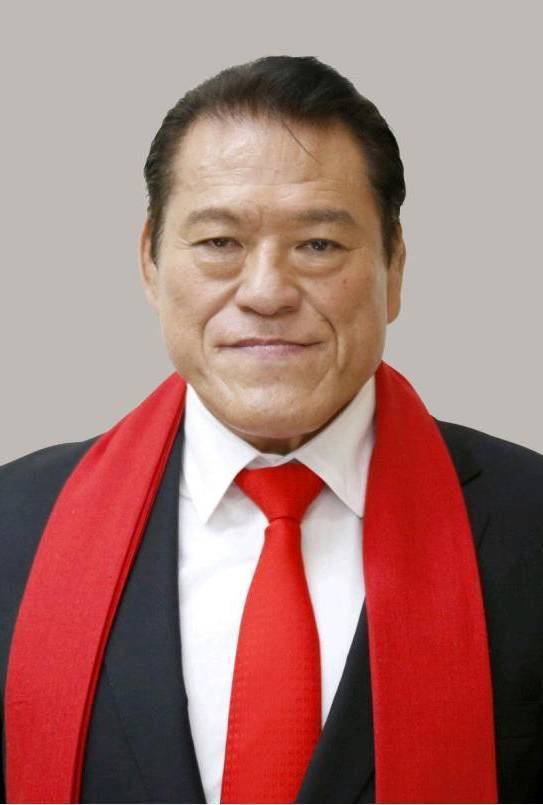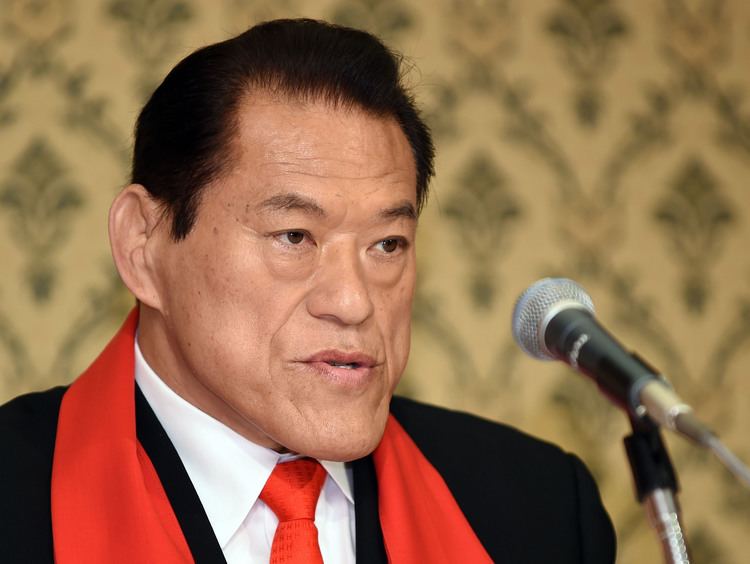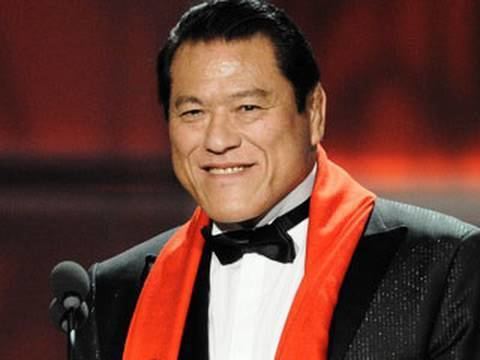Weight 109 kg Residence Tokyo, Japan Name Antonio Inoki Parents Sajiro Inoki | Billed height 6 ft 3 in (1.91 m) Children Hiroko Inoki Billed weight 240 lb (110 kg) Height 1.91 m | |
 | ||
Ring name(s) Antonio InokiMoeru ToukonTokyo Tom Similar People Profiles | ||
Stan Hansen on Antonio Inoki
Antonio Inoki (born Kanji Inoki (猪木寛至, Inoki Kanji) on February 20, 1943) is a Japanese professional wrestling and mixed martial arts promoter, politician, and retired professional wrestler and martial artist. His ring name is a homage to wrestler Antonino Rocca. He also wrestled under the ring names Little Tokyo, Tokyo Tom, among others. He converted to Islam in 1990 and took the name Muhammad Hussain Inoki, something he publicly revealed in 2012.
Contents
- Stan Hansen on Antonio Inoki
- Antonio inoki wrestler politician on expectations for his trip to pyongyang
- Early life
- Japan Wrestling Association 19601966
- Tokyo Pro Wrestling 19661967
- Return to JWA 19671971
- New Japan Pro Wrestling 19721994
- Final Countdown and retirement 1994present
- House of Councillors 19891995
- House of Councillors 2013present
- Personal life
- Religion
- Mixed martial arts involvement
- In media
- In wrestling
- Wrestlers trained
- Championships and accomplishments
- References

Inoki began his professional wrestling career in 1960, working for the Japanese Wrestling Association and became a wrestling promoter in 1972 when he founded New Japan Pro Wrestling (NJPW) that he remained the owner of until 2005 where he sold his controlling share in the promotion to the Yuke's video game company. He later founded the Inoki Genome Federation. He was inducted into the WWE Hall of Fame in 2010. As a professional wrestler he became one of the most respected sport celebrities of Japan, bolstered by his mixed martial arts match against boxer Muhammad Ali in 1976. With Ric Flair, he headlined two shows in North Korea in 1995 that drew 150,000 and 190,000 spectators, the highest attendances in professional wrestling.

In 1989, while still an active wrestler, Inoki entered Japanese politics as he was elected to the Japanese House of Councillors and as part of his first term with the House of Councillors successfully negotiated with Saddam Hussein for the release of Japanese hostages before the outbreak of the Gulf War. His first tenure in the House of Councillors ended in 1995, but he was reelected in 2013.

Antonio inoki wrestler politician on expectations for his trip to pyongyang
Early life

Inoki was born in an affluent family in Yokohama in 1943. He was the sixth son and the second youngest of the seven boys and four girls. His father, Sajiro Inoki, a businessman and politician, died when Kanji was five years old. Inoki entered the Higashidai Grade School. Inoki was taught karate by an older brother while in 6th grade. By the time he was in 7th grade at Terao Junior High School, he was 180 centimeters tall and joined the basketball team. He later quit and joined a track and field club as a shot putter. He eventually won the championship at the Yokohama Junior High School track and field competition.
The family fell on hard times in the post-war years, and in 1957, the 14-year-old Inoki emigrated to Brazil with his grandfather, mother and brothers. His grandfather died during the journey to Brazil. Inoki won regional championships in Brazil in the shot put, discus throw, and javelin throw, and finally the All Brazilian championships in the shot put and discus.
Japan Wrestling Association (1960–1966)
Inoki met Rikidōzan at the age of 17. He went back to Japan for the Japanese Wrestling Association (JWA) as Rikidōzan's disciple. One of his dojo classmates was Giant Baba. After Rikidozan's death, Inoki worked in Baba's shadow until he joined the original Tokyo Pro Wrestling in 1966.
Tokyo Pro Wrestling (1966–1967)
After a long excursion of wrestling in the United States, Inoki found a new home in Tokyo Pro Wrestling. While there, Inoki became their biggest star. Unfortunately, the company folded in 1967, due to turmoil behind the scenes.
Return to JWA (1967–1971)
Returning to JWA in late 1967, Inoki was made Baba's partner and the two dominated the tag team ranks as the "B-I Cannon", winning the NWA International tag team belts four times. Wrestling legend Bruno Sammartino tells a story about Inoki trying to "shoot" him during a tag match in Osaka to build his reputation against the then-world champ. Bruno powered out of the hold, pounded Inoki mercilessly and threw him out of the ring. Inoki allegedly refused to re-enter the ring with Sammartino and tagged in Baba to finish the match.
New Japan Pro Wrestling (1972–1994)
Fired from JWA in late 1971 for planning a takeover of the promotion, Inoki founded New Japan Pro Wrestling (NJPW) in 1972. His first match as a New Japan wrestler was against Karl Gotch.
In June 1979, he fought with Pakistani wrestler Zubair Jhara Pahalwan and lost the fight in the fifth round. In 2014, twenty two years after Zubair Jhara's death, he announced to take Jhara's nephew Haroon Abid under his guardianship.
On November 30, 1979, Inoki defeated WWF Heavyweight Champion Bob Backlund in Tokushima, Japan to win the title. Backlund then won a rematch on December 6. However, WWF president Hisashi Shinma declared the re-match a no contest due to interference from Tiger Jeet Singh, and Inoki remained Champion. Inoki refused the title on the same day, and it was declared vacant. Backlund later defeated Bobby Duncum in a Texas Death match to regain the title on December 12. As Inoki refused the title, his reign is not included nor is it recognized by WWE in its official history, and Backlund is recognized as having one reign from 1978 to 1983.
In 1995 the Japanese and the North Korean governments came together to hold a two-day wrestling festival for peace in Pyongyang, North Korea. The event drew 150,000 and 190,000 fans respectively to Rungnado May Day Stadium. The main event saw the only match between Inoki and Ric Flair, with Inoki coming out on top. Days before this event, Inoki and the Korean press went to the grave and birthplace of Rikidōzan and paid tribute to him.
Final Countdown and retirement (1994–present)
Inoki's retirement from professional wrestling matches came with the staging of the "Final Countdown" series between 1994 and 1998. This was a special series in which Inoki re-lived some of his mixed martial arts matches under professional wrestling rules, as well as rematches of some of his most well known wrestling matches. As part of the Final Countdown tour, Inoki made a rare World Championship Wrestling appearance; defeating WCW World Television Champion Steven Regal in a non-title match at Clash of the Champions XXVIII. Inoki faced Don Frye in the final match of his professional wrestling career.
Culminating in 2006, Inoki's influence within New Japan declined. An example of this has been the purchase of his image by Yuke's, who in 2005 purchased his controlling 51.5% stock in New Japan. As a result, New Japan is now able to control Inoki's appearances and the use of his image. Inoki began a new promotion in 2007 called Inoki Genome Federation that competes with New Japan.
On February 1, 2010, World Wrestling Entertainment (WWE) announced on its Japanese website that Inoki would be inducted into the WWE Hall of Fame as part of the Class of 2010. Inoki was presented with a Hall of Fame certificate by WWE's Ed Wells and stated that he would be attending the WrestleMania XXVI weekend festivities, during which he was inducted by Stan Hansen.
House of Councillors (1989–1995)
Following in his father's footsteps, Inoki entered politics in 1989, when he was elected into the House of Councillors as a representative of his own Sports and Peace Party in the Japanese House of Councillors election, 1989.
In 1990, Inoki traveled to Iraq in "an unofficial one-man diplomatic mission" and successfully negotiated with Saddam Hussein for the release of Japanese hostages before the outbreak of the Gulf War. It was then that he personally organized a wrestling event in Iraq (スポーツと平和の祭典) for the purpose of freeing the 41 captive Japanese nationals. He subsequently retained his seat in the Japanese House of Councillors election, 1992. He failed to win re-election in the Japanese House of Councillors election, 1995 following a number of scandals reported in 1994, and left politics for the next eighteen years.
House of Councillors (2013–present)
On June 5, 2013, Inoki announced that he would again run for a seat in the Japanese Diet under the Japan Restoration Party ticket. Inoki won the election to return to Japan's Upper House as an MP.
In November 2013, he was suspended from the Diet for 30 days because of an unauthorized trip to North Korea. He had visited on the occasion of the 60th anniversary of the armistice in the Korean War, and had met with senior North Korean figure Kim Yong-nam during his visit. This was Inoki's 27th visit to North Korea; he explained in an interview that the North Korean abductions of Japanese citizens had caused the Japanese government to "close the door" on diplomacy with the North, but that the issue would not be resolved without ongoing communication, and that he saw his relationship with North Korean-born Rikidōzan as a crucial link to the people of the North.
He was reportedly considering running for governor of Tokyo in 2014 following another visit to North Korea.
In January 2015, he helped to establish a new party named the Assembly to Energize Japan.
Personal life
Inoki was married to actress Mitsuko Baisho from 1971 to 1987, and together they had a daughter, Hiroko.
Religion
Inoki converted to Shia Islam in 1990 during a pilgrimage to Karbala, the Shiite holy city in Iraq. He was in Iraq negotiating for the release of several Japanese hostages. This was only revealed in 2012, along with the declaration that he had changed his name to Muhammad Hussain Inoki. Inoki has reportedly described himself as both a "Muslim" convert and a Buddhist.
Inoki opened a wrestling themed restaurant in Shinjuku, Tokyo named Antonio's Inoki Sakaba Shinjuku.
Mixed martial arts involvement
Inoki was amongst the group of professional wrestlers who were tutored in the art of hooking and shooting by the professional wrestler Karl Gotch. Inoki named his method of fighting "strong style." This method of wrestling (which was taught to Inoki by Gotch) borrowed heavily from professional wrestling's original catch wrestling roots, and is one of the most important influences of modern shoot wrestling.
Inoki faced many opponents from all dominant disciplines of combat from various parts of the world, such as boxers, judoka, karateka, kung fu practitioners, sumo wrestlers and professional wrestlers. These bouts included a match with then-prominent karate competitor Everett Eddy. Eddy had previously competed in a mixed skills bout against boxer Horst Geisler, losing by knockout. The bout with Eddy ended with the karateka "knocked out" by a professional wrestling powerbomb followed by a Hulk Hogan-esque leg drop. Another such match pitted Inoki against 6'7" Kyokushin karate stylist Willie "The Bear Killer" Williams. (So-called because he had allegedly fought a bear for a 1976 Japanese film entitled "The Strongest Karate 2".) This bout ended in a doctor stoppage after both competitors repeatedly fell out of the ring. Although many of the matches were rigged and scripted, they are seen as a precursor to modern mixed martial arts. When asked about Inoki's fighting skills, business colleague Carlson Gracie stated Inoki was "one of the best fighters he'd seen."
His most famous bout was against heavyweight boxing champion Muhammad Ali on June 26, 1976 in Tokyo. Inoki initially promised Ali a rigged match to get him to fight in Japan, but when the deal materialized, Ali's camp feared that Inoki would turn the fight into a shoot, which many believe was Inoki's intention. Ali visited a professional wrestling match involving Inoki and witnessed Inoki's grappling ability. The rules of the match were announced several months in advance. Two days before the match, however, several new rules were added which severely limited the moves that each man could perform. A rule change that had a major effect on the outcome of this match was that Inoki could only throw a kick if one of his knees was on the ground. In the match, Ali landed a total of six punches to Inoki, and Inoki kept to his back in a defensive position almost the full duration of the match of 15 rounds, hitting Ali with a low kick repeatedly. The bout ended in a draw, 3–3. Ali left without a press conference and suffered damage to his legs as a result of Inoki's repeated leg kicks.
Following his retirement, Inoki has promoted a number of MMA events such as NJPW: Ultimate Crush (which showcased pro wrestling matches and MMA matches on the same card), as well as annual Inoki Bom-Ba-Ye shows which took place on New Year's Eve in 2001, 2002 and 2003. Some of the major attractions of these events involve the best of NJPW against world-renowned fighters in mixed martial arts matches. Inoki vs. Renzo Gracie was a professional wrestling match that took place at Inoki Bom-Ba-Ye 2000 against mixed martial artist Renzo Gracie. Inoki was also the ambassador for the International Fight League's Tokyo entry before that promotion's demise.
In media
Inoki appears both in the manga and anime Tiger Mask, in a secondary role: in the Japanese series he is the only one who was able to win over Naoto Date, i.e. Tiger Mask, and the two became best friends subsequently.
Inoki appeared in the film The Bad News Bears Go to Japan as himself. A subplot in his scenes involved Inoki seeking a rematch with Ali. Gene LeBell, who also appears in these scenes as a manager of Inoki's scheduled opponent, Mean Bones Beaudine, was the referee of Inoki's match with Ali. Inoki's appearance in the film culminates with a match against the main character, Marvin Lazar (played by Tony Curtis), when Beaudine suddenly becomes unavailable to participate. Professional wrestler Héctor Guerrero served as Curtis's stunt double for the wrestling portions of this scene.
Inoki had the starring role in the film Acacia directed by Jinsei Tsuji.
In Oh!Great's manga Air Gear, Inoki is regularly referred to by the author, and also the characters as an influence on their fighting style. The manga also makes several less than complimentary references to Inoki's large chin. Along with Inoki, Steve Austin of the World Wrestling Federation has been referred to in Air Gear's pages, often in naming things. (This is based on the translation by Tanoshimi Manga, and later by Balantine Books/Del Rey Books. Other translations may omit these references)
The pro-wrestler character Kanji Igari in the manga (and anime) series Baki the Grappler is based heavily on Inoki.
In wrestling
Wrestlers trained
Championships and accomplishments
1 ^ Inoki's WWF Heavyweight Championship reign is not officially recognized by WWE.
